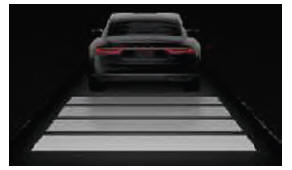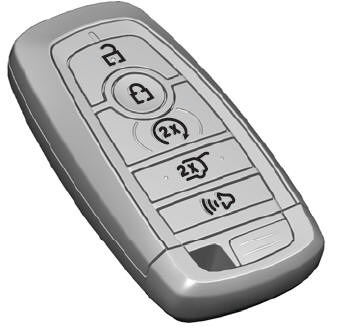Lincoln Aviator: Adaptive Cruise Control / Setting the Adaptive Cruise Control Speed
Drive to the speed you prefer.

 Press either button to set the
current speed.
Press either button to set the
current speed.
Take your foot off the accelerator pedal.
The indicator, current gap setting and set speed appear in the information display.

A vehicle image illuminates if there is a vehicle detected in front of you.
Note: When adaptive cruise control is active, the speedometer may vary slightly from the set speed displayed in the information display.
Setting the Adaptive Cruise Speed from a Complete Stop

 Press and release either button
while keeping the brake pedal fully
pressed.
Press and release either button
while keeping the brake pedal fully
pressed.
The set speed adjusts to 20 mph (30 km/h).
The indicator, current gap setting and set speed appear in the information display.
Manually Changing the Set Speed
 Press and release to increase the
set speed in small increments.
Press and release to increase the
set speed in small increments.
 Press and release to decrease the
set speed in small increments.
Press and release to decrease the
set speed in small increments.
Press and hold either button to change the set speed in large increments. Release the button when you reach the speed you prefer.
Press the accelerator or brake pedal until you reach the speed you prefer. Press either button to select the current speed as the set speed.
The system may apply the brakes to slow the vehicle to the new set speed. The set speed displays continuously in the information display when the system is active.
 Switching Adaptive Cruise Control On and Off
Switching Adaptive Cruise Control On and Off
The cruise controls are on the steering
wheel.
Switching Adaptive Cruise Control On
Press the button to set the
system
in standby mode.
The indicator, current gap setting and set
speed appear in the information display...
 Setting the Adaptive Cruise Control Gap
Setting the Adaptive Cruise Control Gap
Press the button to cycle through
the four gap settings.
The selected gap appears in the instrument
cluster display as shown by the bars in the
image...
Other information:
Lincoln Aviator 2020-2025 Service Manual: Removal and Installation - Thermostatic Expansion Valve - 3.0L EcoBoost
Removal NOTICE: During the removal of components, cap, tape or otherwise appropriately protect all openings to prevent the ingress of dirt or other contamination. Remove protective materials prior to installation. NOTE: Removal steps in this procedure may contain installation details...
Lincoln Aviator 2020-2025 Service Manual: Specifications
Lubricants, Fluids, Sealers and Adhesives NOTICE: Do not over-lubricate the driveshaft components. Using excessive grease may damage the driveshaft components. NOTE: Wipe off any excess grease. Item Description Specification Rear driveshaft: Front tube plunging splines Material: Motorcraft® Premium Long-Life Grease / XG-1-E1 (ESA-M1C75-B) ESA-M1C75-B Rear driveshaft: Alignment bushing Material: Motorcraft® Premium Long-Life Grease / XG-1-E1 (ESA-M1C75-B) ESA-M1C75-B Rear driveshaft: Rear CV-joint splines Material: Motorcraft® Premium Long-Life Grease / XG-1-E1 (ESA-M1C75-B) ESA-M1C75-B Front driveshaft: Front axle end plug-on yoke splines Material: Slip Yoke Grease / 5L3Z-19A506-A - Front driveshaft: Transfer case output shaft splines Material: Motorcraft® High Temperature 4x4 Front Axle and Wheel Bearing Grease / XG-11 (WSS-M1C267-A1) WSS-M1C267-A1 Front Driveshaft Item 3...
Categories
- Manuals Home
- Lincoln Aviator Owners Manual
- Lincoln Aviator Service Manual
- Description and Operation - Body and Frame
- Remove and Reinstall the Battery
- Fuel Quality
- New on site
- Most important about car
Remote Control
Passive Key

The passive key operates the power locks and the remote start system. The passive key must be in your vehicle to use the push button start.
Note: You may not be able to shift out of park (P) unless the passive key is inside your vehicle.
